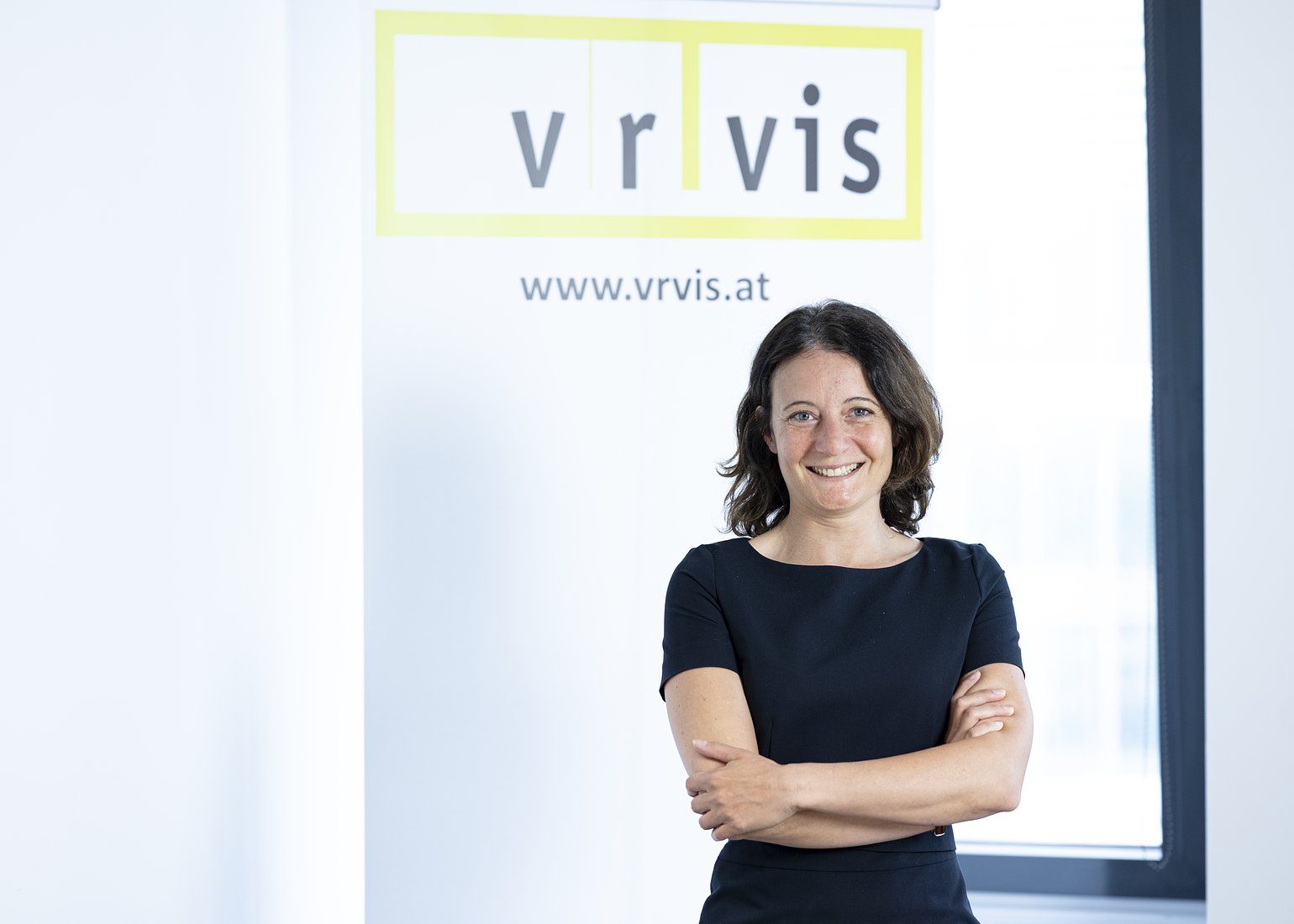#AlumniStories: Johanna Schmidt
The head of VRVis’ Visual Analytics Research Group tells us why bars are better than pies. And how she found her way as a researcher, manager, and lecturer.

About
Johanna Schmidt is specializing in visual analytics research. She earned her master’s in Visual Computing in 2011 and completed her Ph.D. in 2016 under Eduard Gröller at the Research Unit for Computer Graphics. She worked at AIT and is currently Head of Visual Analytics at VRVis. Her research focuses on big data visualization and analytics. Johanna also teaches visualization at TU Wien Informatics.
You’re the head of VRVis’ Visual Analytics Research Group – What is your job about?
VRVis (Center for Research in Virtual Reality and Visualization) is one of Austria’s leading institutes for visual computing. We closely collaborate with companies, so our research is mainly application-oriented. But of course, in this field, you need basic research. It’s the pleasure and challenge of an application-oriented research company that we’re covering both. My group’s main area is visual analytics, so we’re using data visualization to gain insight into big data. The simplest technical explanation is that we’re investigating how we can translate data elements into visual elements – it’s basically a mapping from data points to visuals on the computer screen. Right now, we’re in the midst of an extensive research project on hydropower: Digi-Hydro. Hydropower is the primary source of energy generation in Austria, and most power plants have been in the grid for a very long time. What wasn’t predicted is that the increasing electricity production from renewable sources is causing fluctuations in the power grid. The machines are not made to be constantly switched on and off to compensate for peaks. Most plants are not even equipped with the tech needed to analyze and contain these critical problems. So, we’re updating their digital infrastructure to collect a massive amount of sensor data. We’re trying to recognize and visualize patterns from these vast data sets to identify whether the machine is currently in a critical state. This way, we ultimately support the power plant operators in immediately tackling problems with the power supply.
Why visual analytics?
I want to make big data understandable. Analyzing data and extracting the relevant information is the first step, but communicating this information to people with different backgrounds is crucial. This is where visualization comes in. We humans are evolutionarily prepared to be able to process visual information fast. Before we could even read, we were already dependent on being able to interpret colors and shapes immediately. Unfortunately, though, we’re terrible at quickly interpreting a series of numbers.
That’s why we use machines to support us in data analytics and visualization. But don’t be fooled – although our tools for understanding data have developed greatly, effectively communicating information is still tricky. For example, colors, shapes, and patterns influence our understanding of data immensely. Research shows that people are bad at comparing graph areas with each other – a pie chart is, therefore, less easy to read than a bar chart, in which the values of the individual bars can be read accurately.
As an alumna, how do you reflect on your studies at TU Wien Informatics?
It was a journey of challenges and discoveries. I loved the broad array of subjects available, allowing me the freedom to explore and truly delve into areas of interest. Ultimately, this helped me to specialize and find my “niche”. But, the initial transition was tough, coming from an AHS (General High School). The technical and foundational aspects of the courses were a steep learning curve, as my previous education hadn’t entirely prepared me for it. However, persistence pays off: The master’s program was a turning point, as I became more immersed in applications and real-world scenarios. It felt like a reward for my resilience during the early stages of my academic journey. That’s why I decided to do my Ph.D. in visual computing with Eduard Gröller as my supervisor.
What led you to a career in research?
It started at the Research Unit for Computer Graphics, where I got a position as a university assistant while working on my dissertation on “Scalable Comparative Visualisation”. I would have loved to continue working at TU Wien Informatics, but unfortunately, there was no funding for a further position in the area then. I took up a role as a scientist at AIT (Austrian Institute of Technology), where I developed visual analytics solutions to assist domain experts in handling extensive movement data. But then, VRVis successfully enticed me to join them, offering me the role of leading the Visual Analytics group. The opportunity to steer a team specializing in Visual Analytics was too appealing to pass up – whereas the transition into a managing role has its challenges, I’m excited to now have a team of bright young researchers to work with. Also, I found my way back to TU Wien Informatics, where I teach visualization and visual data science at the Bachelor’s and Master’s level. Balancing both roles allows me to share knowledge about my research and the field as a whole and gain new insights into my domain by working with students.
What are the future changes and challenges in your field?
We all know that today’s advanced innovations swiftly become yesterday’s news in informatics. That’s why we are consistently venturing into new approaches and striving to learn from other fields. Yet, the allure of visual analytics lies precisely in this constant state of flux. We are working on current issues directly with the users, in our case, mostly domain experts in the industries. That is what excites me. On many occasions, truly understanding the problem in a specific area – for example, in a manufacturing company – takes longer than actually devising solutions. It requires continuous learning and adaptation, as well as the ability to devise creative approaches. Learn more about Johanna and her projects at VRVis, find her on LinkedIn, and check out what she has to say about data visualization on ORF.at (in German).
About Johanna Schmidt
Johanna Schmidt studied computer science at TU Wien Informatics with a special focus on visual computing. Besides her studies, she was working part-time as a software engineer for different companies. Johanna received her master’s degree in 2011 and afterward continued with a Ph.D. in visualization, supervised by Eduard Gröller at the Research Unit for Computer Graphics, which she finished in 2016. Then, she worked as a scientist at AIT (Austrian Institute of Technology), where she was responsible for developing visual analytics solutions for domain experts working with large movement data. In 2019, she joined the VRVis, where she became Head of the Visual Analytics group in July 2020. Johanna Schmidt’s primary research focus is on information visualization and visual analytics of large time-series data. She works with interactive visual systems that can support tasks like data quality assessment, decision-making, and predictive modeling. Johanna Schmidt authored several publications published in high-impact journals like IEEE TVCG and Computer Graphics Forum and in highly relevant visualization conference proceedings. Johanna is also a lecturer at the TU Wien Informatics, the University of Applied Sciences Salzburg, and the University of Applied Sciences Krems and speaks at events (Women in Data Science, WeAreDevelopers, Data Governance Week, B2B Software Days, etc).
About VRVis
VRVis is Austria’s leading research center in the field of visual computing. Their team, comprising more than 70 employees, is committed to innovative application-oriented research and development projects. As a COMET Competence Center, they aim to build a bridge between research and practice with their partners from science, business, and industry. VRVis Zentrum für Virtual Reality und Visualisierung Forschungs-GmbH is funded by BMK, BMAW, Styria, SFG, Tyrol, and Vienna Business Agency in the scope of COMET - Competence Centers for Excellent Technologies (879730) which is managed by FFG.
Curious about our other news? Subscribe to our news feed, calendar, or newsletter, or follow us on social media.



